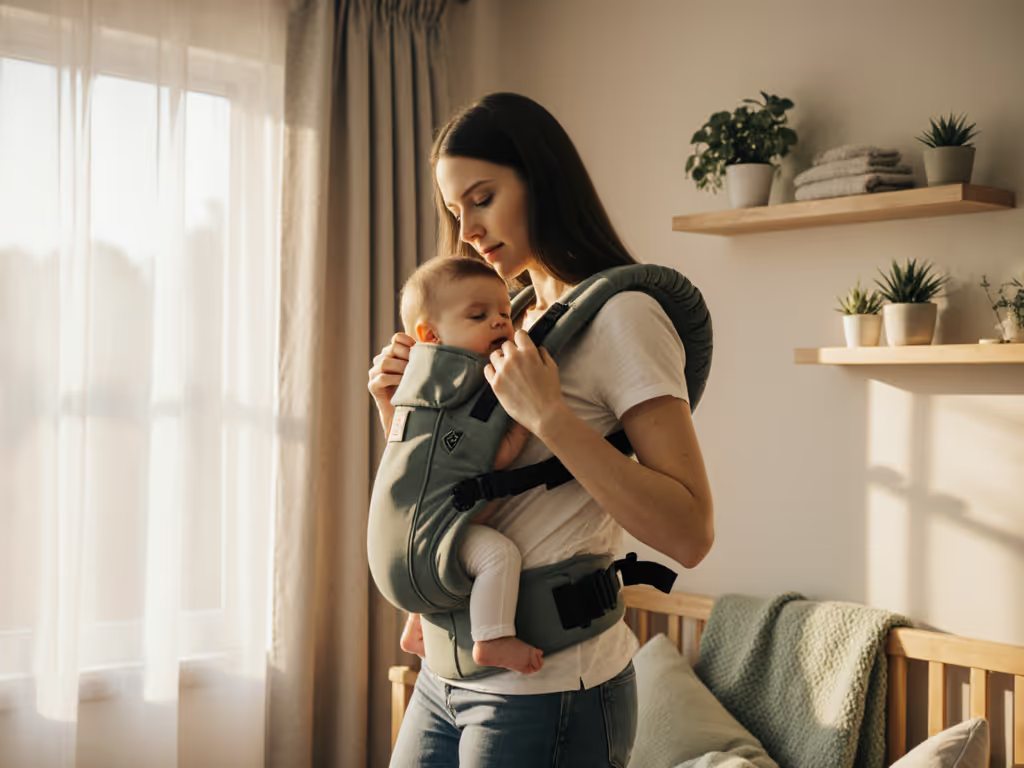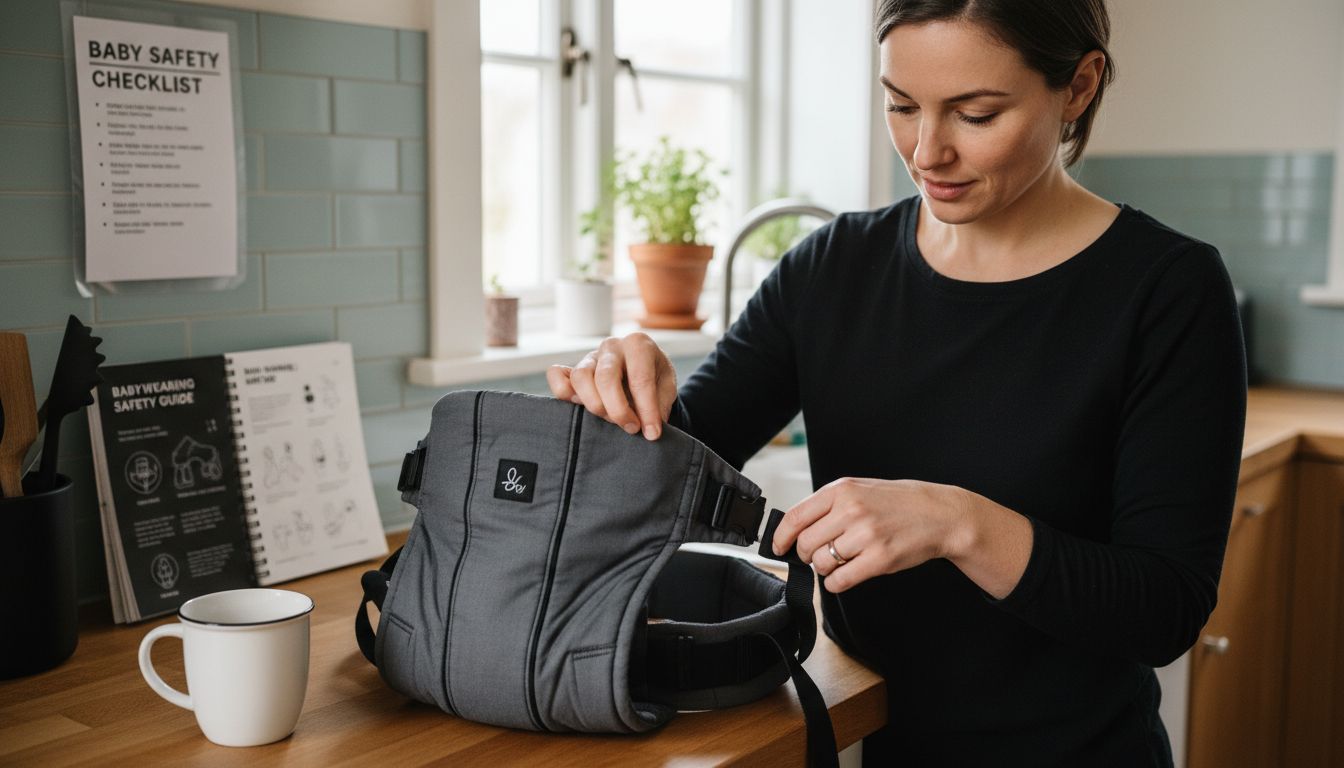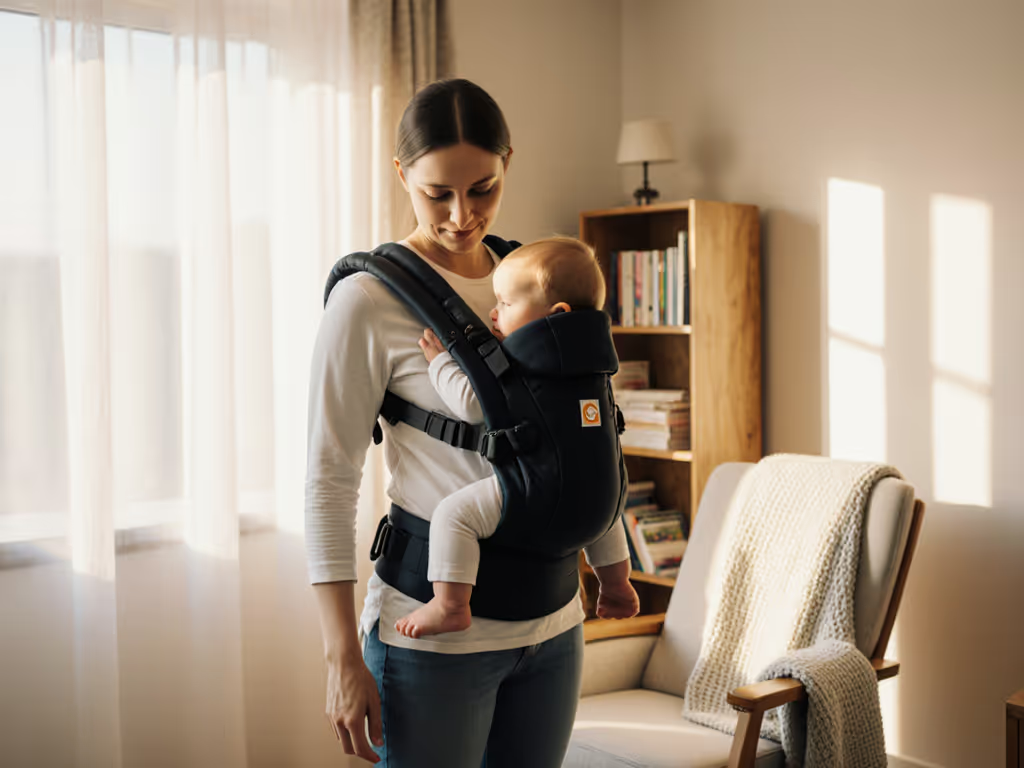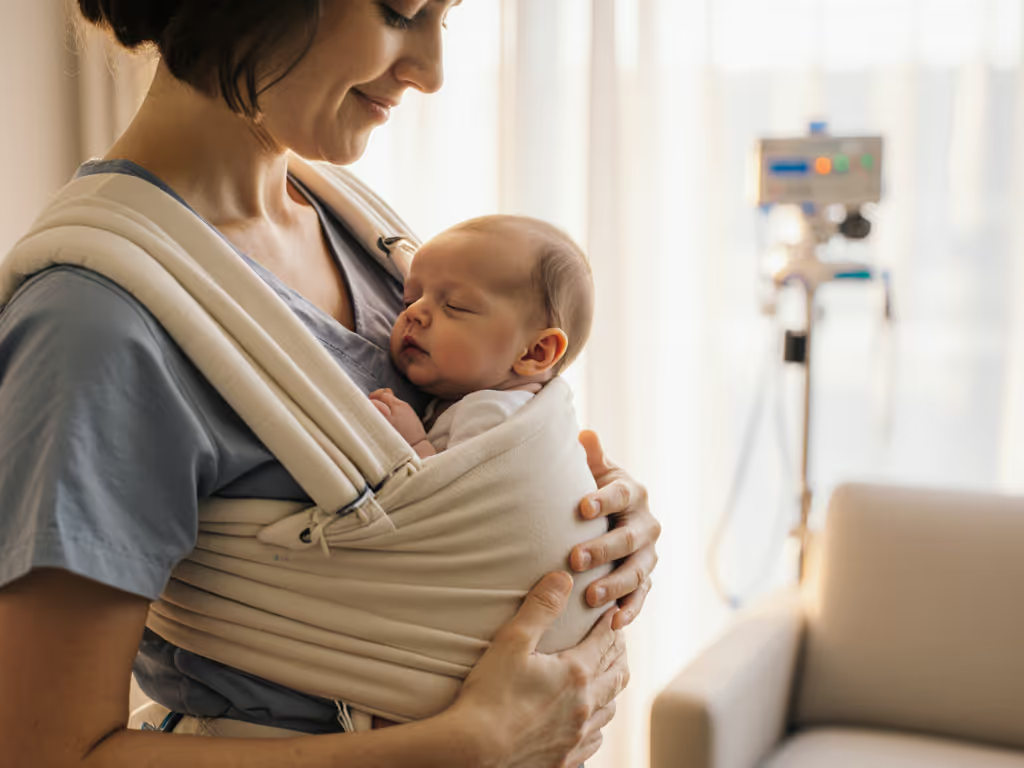
Babywearing Safety Guide 2025: Ensure Safe, Confident Carrying

Did you know that improper carrier use is linked to hundreds of infant injuries each year, according to the U.S. Consumer Product Safety Commission? Babywearing can offer soothing comfort and closeness, but safety must always come first. Whether you are a new parent or looking to refine your technique, learning key steps for safe babywearing gives you peace of mind while keeping your baby secure and comfortable.
Quick Summary
| Key Point | Explanation |
|---|---|
| 1. Assess Baby's Readiness First | Check your baby's age, head control, and comfort before babywearing. Consult a pediatrician for specific concerns like respiratory issues. |
| 2. Choose a Safe and Supportive Carrier | Select a carrier that positions your baby in an 'M' shape for healthy hip development. Consider safety features and age recommendations carefully. |
| 3. Properly Set Up the Carrier | Ensure all straps and buckles function correctly before use. Position your baby so their head is at kissing height and airway is open. |
| 4. Regularly Check Baby's Position | Maintain visibility on your baby's face, ensuring clear airways and proper spinal alignment. Use the 'kiss test' to confirm correct positioning. |
| 5. Conduct Routine Safety Inspections | Inspect your carrier before each use for wear and check that it's securely fastened. This routine ensures your baby's safety and comfort. |
 |
|
Step 1: Assess Your Baby's Readiness and Needs
Before you start babywearing, understanding your infant's physical readiness is crucial for safe carrying. This step will help you evaluate whether your baby is prepared for different carrying positions and carrier types.
First, consider your baby's age and developmental stage. Newborns and very young infants require specific support and positioning that differs from older babies. The U.S. Consumer Product Safety Commission strongly advises caution with infants younger than four months, especially those who are premature, have low birth weight, or have existing respiratory conditions.
Your pediatrician should be your first consultation point. According to the American Academy of Pediatrics, babies with respiratory problems or those born prematurely need special consideration before being placed in any carrying device. These infants might have difficulty maintaining proper breathing positions.
Check your baby's neck and head control. A safe carrier requires that your infant can:
- Hold their head steady
- Support their neck independently
- Maintain a proper airway without assistance
Watch for signs that your baby is not ready for babywearing. Red flags include:
- Difficulty breathing
- Inability to lift or turn their head
- Appearing uncomfortable or distressed when positioned
Pro Tip: When in doubt, always consult your pediatrician. They can provide personalized guidance based on your baby's unique health profile.
Once you understand your baby's readiness, you are prepared to move forward with selecting an appropriate carrier and learning proper wearing techniques. The next step will focus on matching your baby's needs with the right carrier design.
Step 2: Select the Safest Carrier for Your Situation
Choosing the right baby carrier is more than just picking a stylish accessory. Your selection will directly impact your baby's safety, comfort, and physical development. This step walks you through selecting a carrier that protects and supports your little one.
Start by understanding the key safety features recommended by child health experts. Hospital for Special Surgery experts emphasize the importance of a carrier that positions your baby in an 'M' or frog shape. This means your baby's hips and knees should be bent with hips spread wide apart. This positioning is critical for healthy hip development.
Look for carriers made of sturdy fabric with secure straps and fastenings. The material should be strong enough to support your baby's weight while preventing any risk of slipping. If you are considering a backpack style carrier, ensure the frame is padded and made of safe materials like aluminum with protective covering.
Key safety criteria for your carrier selection include:
- Snug fit against your body
- Supportive back positioning
- Leg holes that prevent slipping
- Ability to maintain baby's natural spine curve
- Breathable fabric
Pay close attention to your baby's size and weight. Not all carriers are universal. Some are designed specifically for newborns while others work better for older infants. Check the manufacturer's weight and age recommendations carefully.
Here's a summary of key safety criteria for different baby carrier types:
| Criteria | Soft Wraps/Slings | Structured Carriers | Backpack Carriers |
|---|---|---|---|
| Age/Weight Range | Newborns<br>Low weight | Infants<br>Toddlers | Older infants<br>12+ months |
| Head/Neck Support | High | Adjustable | Minimal |
| Hip/Knee Position | 'M' shape possible | Built-in 'M' support | Varies by model |
| Breathability | High | Moderate | High |
| Fit Adjustability | Tied manually | Buckles/straps | Back/shoulder straps |
| Safety Notes | Requires correct tying | Check size and weight limits | Ensure frame is padded |
Pro Tip: Always do a careful trial fitting before purchasing. A carrier should feel secure and comfortable for both you and your baby.
Your carrier choice sets the foundation for safe and enjoyable babywearing. With the right carrier selected, you are ready to learn proper wearing techniques in the next section.
Step 3: Set Up and Adjust the Baby Carrier Properly
Properly setting up your baby carrier is a critical step that ensures both your comfort and your baby's safety. This section will guide you through precise adjustments that protect your little one while keeping you comfortable during babywearing.
Begin by examining the carrier before putting your baby inside. Check all straps, buckles, and fastenings to confirm they are in perfect working condition. The Hospital for Special Surgery recommends positioning your baby facing inward and close enough that you can comfortably kiss the top of their head.
Focus on creating the ideal positioning. Your baby's legs should form an 'M' shape with their knees higher than their bottom. This natural positioning supports healthy hip development and prevents unnecessary strain on their developing joints. Ensure the carrier provides complete back support while keeping your baby's spine in a gentle curved position.
Pay special attention to your baby's head and neck. For newborns and younger infants, extra head support is crucial. Position them so their chin is not tucked against their chest. This prevents potential breathing difficulties and ensures an open airway. The carrier should allow your baby to move their head slightly while keeping them secure.
Key adjustment steps include:
- Align carrier straps evenly
- Distribute weight across your shoulders and hips
- Ensure baby sits high enough to monitor breathing
- Verify no fabric is covering baby's face
- Check that carrier feels snug but not restrictive
Pro Tip: Practice carrier setup at home before attempting it while holding your baby. Familiarity breeds confidence and safety.
With your carrier properly adjusted, you are now prepared for safe and comfortable babywearing. The next steps will focus on maintaining awareness and monitoring your baby's position during carrying.
Step 4: Position Baby for Optimal Support and Airway Safety
Correctly positioning your baby in a carrier is not just about comfort it is about preventing potential life threatening risks. The U.S. Consumer Product Safety Commission highlights critical positioning guidelines that every parent must understand to ensure their infant remains safe.
Visibility is your first priority. Your baby's face should always be completely visible and unobstructed. This means no fabric covering their mouth or nose and no pressing against your body in a way that could restrict breathing. The Hospital for Special Surgery recommends maintaining a clear line of sight to monitor your baby's respiratory patterns.
Breathing mechanics are crucial. Position your baby so their chin is not tucked against their chest. This chin to chest position can compress the airway and potentially lead to breathing difficulties. Newborns and younger infants are particularly vulnerable to positional breathing challenges.
Support your baby's natural body mechanics. Their spine should maintain a gentle curved position with legs spread in the classic 'M' shape. This positioning not only supports healthy hip development but also helps distribute their weight evenly. Your baby should feel secure yet able to move slightly within the carrier.
Key positioning checkpoints include:
- Clear facial visibility
- Chin lifted away from chest
- Spine in natural curve
- Legs spread wide
- No fabric blocking airways
Pro Tip: Periodically check your baby's position by doing the "kiss test" if you can comfortably kiss the top of their head they are positioned correctly.
With your baby safely positioned you are now ready to move confidently while wearing your carrier. The next section will cover monitoring techniques to maintain ongoing safety during your babywearing journey.
Step 5: Check Fit, Comfort and Security Every Time
Every babywearing journey requires constant vigilance and routine safety checks. The American Academy of Pediatrics recommends performing a comprehensive inspection before each use to ensure your baby remains protected and comfortable.
Start with a thorough visual and tactile examination of your carrier. Look for any signs of wear including small tears, loose threads, or compromised fabric integrity. The Hospital for Special Surgery emphasizes that even minor damage can significantly impact carrier performance and your baby's safety.
Perform a quick fit assessment focusing on multiple critical areas. Check that all straps are correctly adjusted and fastenings are securely locked. Your carrier should feel snug against your body without creating pressure points or causing strain. The baby should be positioned high enough that you can easily monitor their breathing and facial expressions.
Confirm your baby's positioning matches safety guidelines. Their head should be supported with clear airways. Legs should maintain the recommended 'M' shape with knees higher than their bottom. Verify that no fabric obstructs their face and they can move their head slightly within the carrier.
Key security checkpoints include:
- Inspect carrier material for wear
- Test all buckles and straps
- Confirm baby's optimal positioning
- Check weight distribution
- Ensure unrestricted breathing
Pro Tip: Create a 30 second safety ritual you perform every time before putting on the carrier. Consistency builds muscle memory and reduces risk.
By systematically checking these elements each time you wear your baby you create a safety protocol that protects both you and your infant. The next section will help you understand ongoing monitoring techniques during active babywearing.
Master Babywearing Safety with Confidence and Care
Navigating the essential steps of babywearing safety can feel overwhelming, especially when it comes to ensuring your little one’s positioning, airway clarity, and comfort. This guide highlights common challenges like choosing the right carrier, achieving the ideal 'M' shape leg positioning, and maintaining constant safety checks that every caregiver faces. If you want to feel confident in your daily babywearing routine while protecting your infant’s health and comfort, expert guidance is crucial.
At Caregiver Carry, you will find trusted, evidence-based resources tailored to help you select safe carriers designed with newborn neck and hip support in mind. Explore detailed baby carrier buying guides and practical safety checklists crafted to simplify your choices and boost your confidence. Do not wait until a small mistake compromises your baby's safety. Visit us today to learn the essential skills that make babywearing both secure and joyful.
Frequently Asked Questions
How can I assess my baby's readiness for babywearing?
Before starting babywearing, check your baby's age and developmental stage. Ensure your baby can hold their head steady, support their neck independently, and maintain an open airway, particularly if they are under four months old.
What safety features should I look for in a baby carrier?
Choose a carrier that allows for an 'M' or frog leg position, ensuring your baby's hips are spread wide and knees are bent. Also, ensure the carrier has sturdy fabric, secure straps, and proper back support to protect your baby's development.
How do I properly set up a baby carrier?
Inspect your carrier's straps and fastenings before use and ensure it's snug against your body. Position your baby's legs in an 'M' shape and make sure their chin is not tucked against their chest to prevent any airway restriction.
What should I check to ensure my baby is safely positioned in the carrier?
Always check that your baby's face is visible and that their chin is lifted away from their chest. They should be positioned high enough for you to monitor their breathing easily and have no fabric obstructing their airways.
How often should I perform safety checks on my baby carrier?
Conduct a quick inspection every time you use the carrier, focusing on the integrity of the material, security of the straps, and your baby's positioning. This routine ensures both you and your baby are safe and comfortable during each wear.
What ongoing monitoring techniques can I use during babywearing?
Regularly check your baby's position and comfort while wearing the carrier. Make sure to perform the 'kiss test' frequently—if you can easily kiss the top of your baby's head, they're positioned correctly, supporting both safety and interaction.



